Global Business Strategies and Tesco: A Comprehensive Report
VerifiedAdded on 2022/11/29
|9
|2297
|499
Report
AI Summary
This report examines various aspects of global business, utilizing Tesco as a case study to illustrate key concepts. It begins with an introduction to global businesses and their operational differences compared to international businesses, using Tesco as an example. The main body delves into Tesco's current market position in the UK, analyzing its target audience and the competitive landscape. It then explores intellectual property rights in a globalized economy, focusing on copyright, patents, and trademarks. The report further discusses managing business functions in an international context, including the significance of hiring local employees and adapting strategies to cultural differences. It also covers the impact of national culture on international marketing activities and various entry strategies into international markets, such as exporting, joint ventures, and piggybacking. The report concludes with global strategies for local companies, emphasizing online presence, hygienic production, and the use of natural products. The conclusion summarizes the key findings, emphasizing the importance of globalization, market analysis, and cultural sensitivity in international business. References and a poster are included in the appendix.
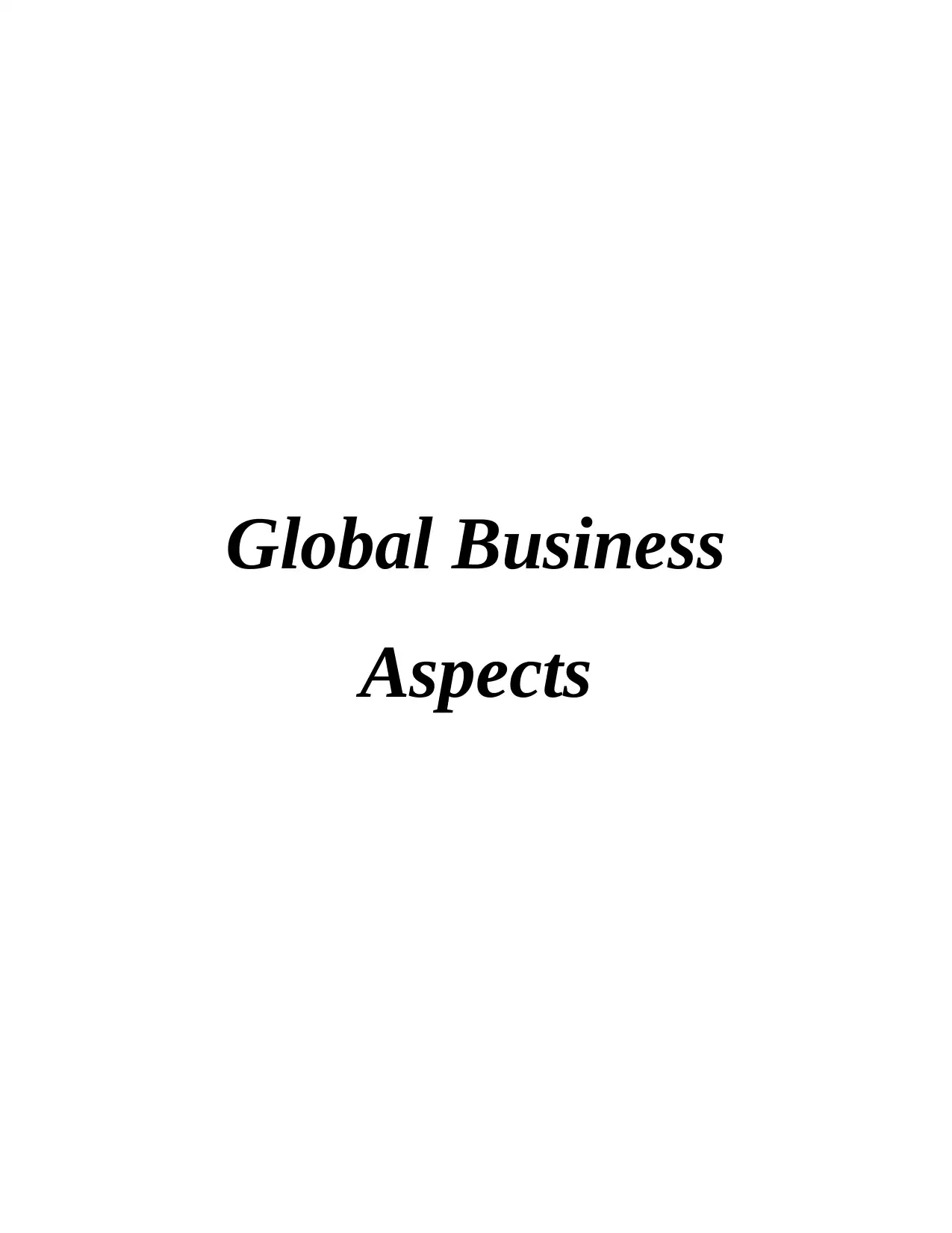
Global Business
Aspects
Aspects
Paraphrase This Document
Need a fresh take? Get an instant paraphrase of this document with our AI Paraphraser
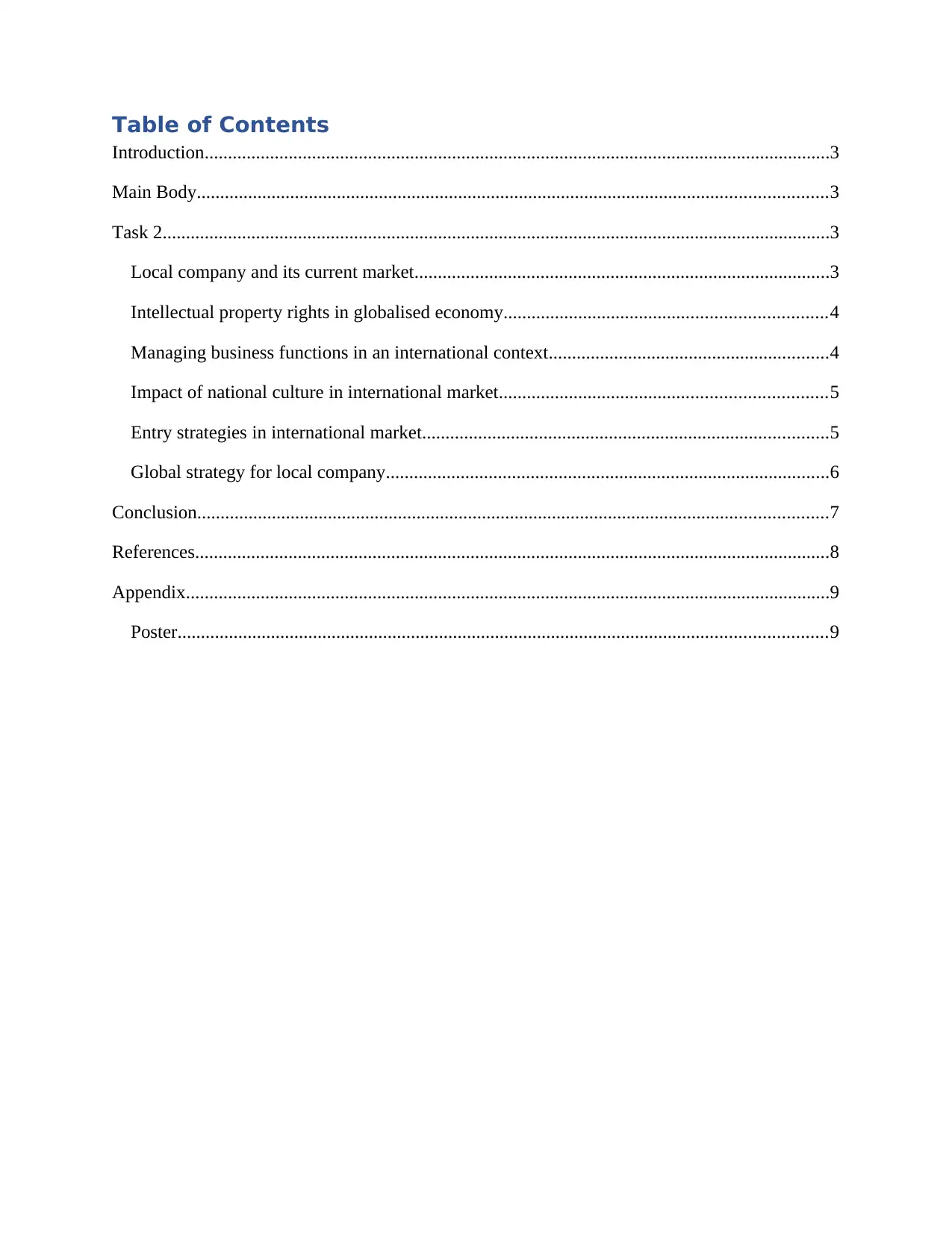
Table of Contents
Introduction......................................................................................................................................3
Main Body.......................................................................................................................................3
Task 2...............................................................................................................................................3
Local company and its current market.........................................................................................3
Intellectual property rights in globalised economy.....................................................................4
Managing business functions in an international context............................................................4
Impact of national culture in international market......................................................................5
Entry strategies in international market.......................................................................................5
Global strategy for local company...............................................................................................6
Conclusion.......................................................................................................................................7
References........................................................................................................................................8
Appendix..........................................................................................................................................9
Poster...........................................................................................................................................9
Introduction......................................................................................................................................3
Main Body.......................................................................................................................................3
Task 2...............................................................................................................................................3
Local company and its current market.........................................................................................3
Intellectual property rights in globalised economy.....................................................................4
Managing business functions in an international context............................................................4
Impact of national culture in international market......................................................................5
Entry strategies in international market.......................................................................................5
Global strategy for local company...............................................................................................6
Conclusion.......................................................................................................................................7
References........................................................................................................................................8
Appendix..........................................................................................................................................9
Poster...........................................................................................................................................9
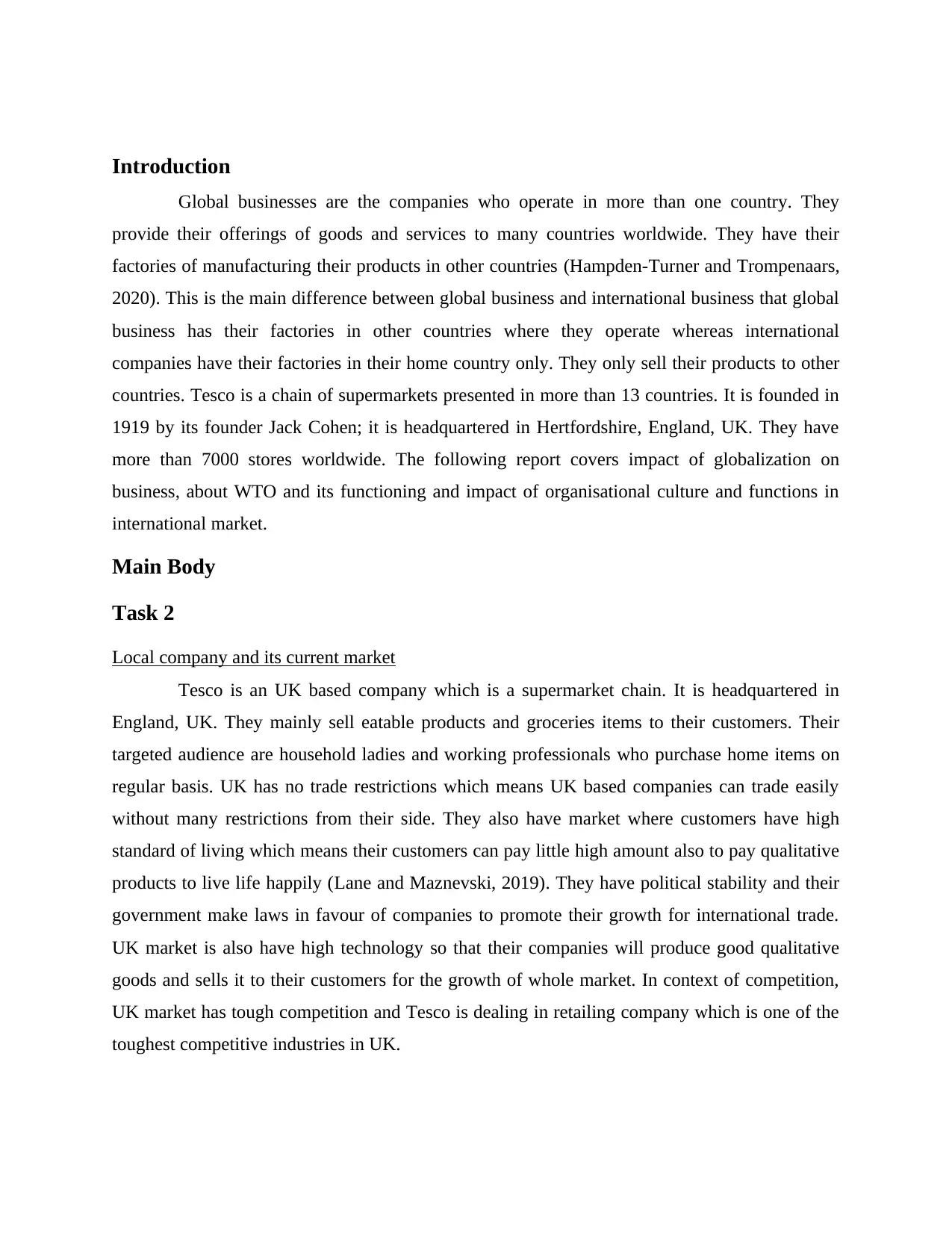
Introduction
Global businesses are the companies who operate in more than one country. They
provide their offerings of goods and services to many countries worldwide. They have their
factories of manufacturing their products in other countries (Hampden-Turner and Trompenaars,
2020). This is the main difference between global business and international business that global
business has their factories in other countries where they operate whereas international
companies have their factories in their home country only. They only sell their products to other
countries. Tesco is a chain of supermarkets presented in more than 13 countries. It is founded in
1919 by its founder Jack Cohen; it is headquartered in Hertfordshire, England, UK. They have
more than 7000 stores worldwide. The following report covers impact of globalization on
business, about WTO and its functioning and impact of organisational culture and functions in
international market.
Main Body
Task 2
Local company and its current market
Tesco is an UK based company which is a supermarket chain. It is headquartered in
England, UK. They mainly sell eatable products and groceries items to their customers. Their
targeted audience are household ladies and working professionals who purchase home items on
regular basis. UK has no trade restrictions which means UK based companies can trade easily
without many restrictions from their side. They also have market where customers have high
standard of living which means their customers can pay little high amount also to pay qualitative
products to live life happily (Lane and Maznevski, 2019). They have political stability and their
government make laws in favour of companies to promote their growth for international trade.
UK market is also have high technology so that their companies will produce good qualitative
goods and sells it to their customers for the growth of whole market. In context of competition,
UK market has tough competition and Tesco is dealing in retailing company which is one of the
toughest competitive industries in UK.
Global businesses are the companies who operate in more than one country. They
provide their offerings of goods and services to many countries worldwide. They have their
factories of manufacturing their products in other countries (Hampden-Turner and Trompenaars,
2020). This is the main difference between global business and international business that global
business has their factories in other countries where they operate whereas international
companies have their factories in their home country only. They only sell their products to other
countries. Tesco is a chain of supermarkets presented in more than 13 countries. It is founded in
1919 by its founder Jack Cohen; it is headquartered in Hertfordshire, England, UK. They have
more than 7000 stores worldwide. The following report covers impact of globalization on
business, about WTO and its functioning and impact of organisational culture and functions in
international market.
Main Body
Task 2
Local company and its current market
Tesco is an UK based company which is a supermarket chain. It is headquartered in
England, UK. They mainly sell eatable products and groceries items to their customers. Their
targeted audience are household ladies and working professionals who purchase home items on
regular basis. UK has no trade restrictions which means UK based companies can trade easily
without many restrictions from their side. They also have market where customers have high
standard of living which means their customers can pay little high amount also to pay qualitative
products to live life happily (Lane and Maznevski, 2019). They have political stability and their
government make laws in favour of companies to promote their growth for international trade.
UK market is also have high technology so that their companies will produce good qualitative
goods and sells it to their customers for the growth of whole market. In context of competition,
UK market has tough competition and Tesco is dealing in retailing company which is one of the
toughest competitive industries in UK.
⊘ This is a preview!⊘
Do you want full access?
Subscribe today to unlock all pages.

Trusted by 1+ million students worldwide
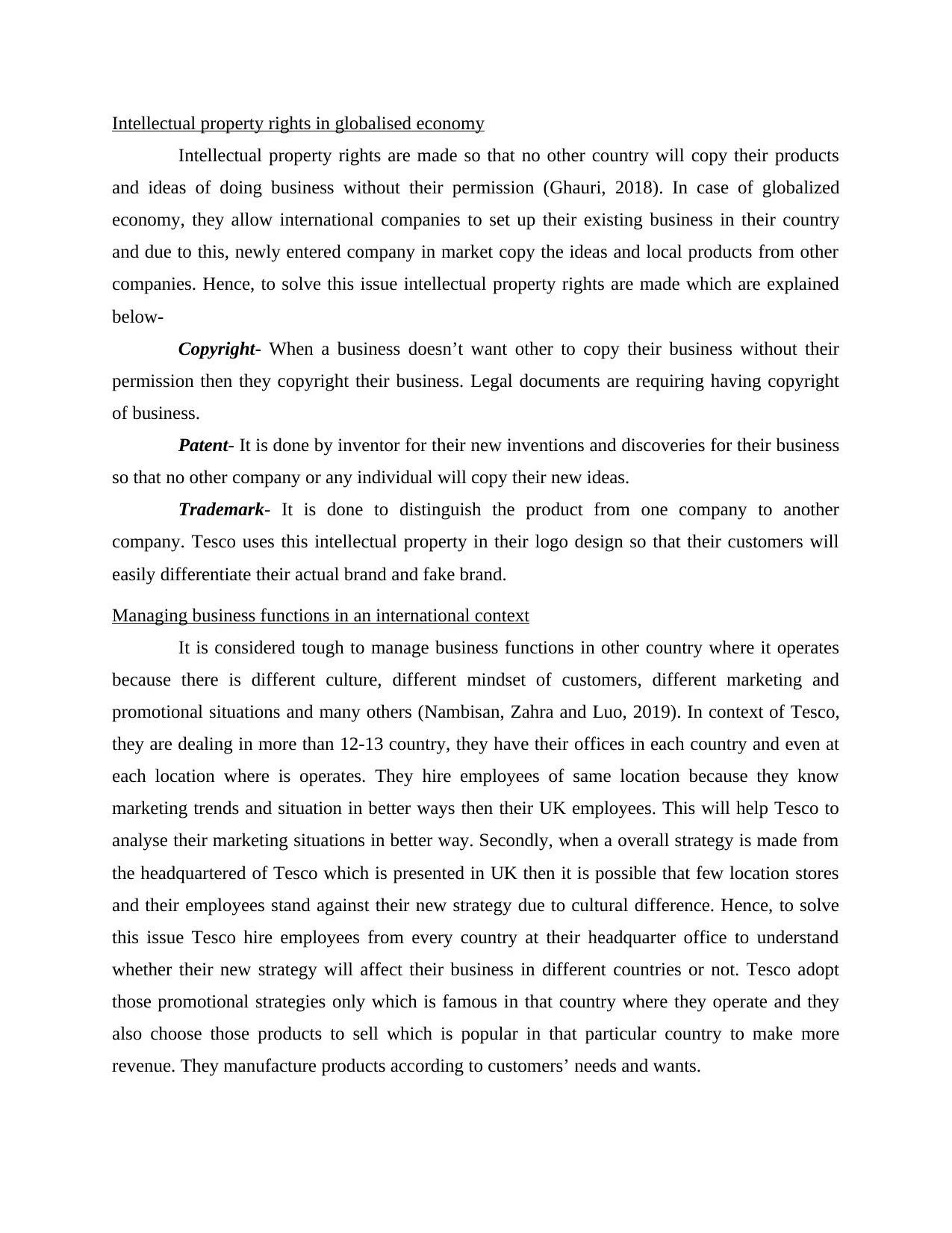
Intellectual property rights in globalised economy
Intellectual property rights are made so that no other country will copy their products
and ideas of doing business without their permission (Ghauri, 2018). In case of globalized
economy, they allow international companies to set up their existing business in their country
and due to this, newly entered company in market copy the ideas and local products from other
companies. Hence, to solve this issue intellectual property rights are made which are explained
below-
Copyright- When a business doesn’t want other to copy their business without their
permission then they copyright their business. Legal documents are requiring having copyright
of business.
Patent- It is done by inventor for their new inventions and discoveries for their business
so that no other company or any individual will copy their new ideas.
Trademark- It is done to distinguish the product from one company to another
company. Tesco uses this intellectual property in their logo design so that their customers will
easily differentiate their actual brand and fake brand.
Managing business functions in an international context
It is considered tough to manage business functions in other country where it operates
because there is different culture, different mindset of customers, different marketing and
promotional situations and many others (Nambisan, Zahra and Luo, 2019). In context of Tesco,
they are dealing in more than 12-13 country, they have their offices in each country and even at
each location where is operates. They hire employees of same location because they know
marketing trends and situation in better ways then their UK employees. This will help Tesco to
analyse their marketing situations in better way. Secondly, when a overall strategy is made from
the headquartered of Tesco which is presented in UK then it is possible that few location stores
and their employees stand against their new strategy due to cultural difference. Hence, to solve
this issue Tesco hire employees from every country at their headquarter office to understand
whether their new strategy will affect their business in different countries or not. Tesco adopt
those promotional strategies only which is famous in that country where they operate and they
also choose those products to sell which is popular in that particular country to make more
revenue. They manufacture products according to customers’ needs and wants.
Intellectual property rights are made so that no other country will copy their products
and ideas of doing business without their permission (Ghauri, 2018). In case of globalized
economy, they allow international companies to set up their existing business in their country
and due to this, newly entered company in market copy the ideas and local products from other
companies. Hence, to solve this issue intellectual property rights are made which are explained
below-
Copyright- When a business doesn’t want other to copy their business without their
permission then they copyright their business. Legal documents are requiring having copyright
of business.
Patent- It is done by inventor for their new inventions and discoveries for their business
so that no other company or any individual will copy their new ideas.
Trademark- It is done to distinguish the product from one company to another
company. Tesco uses this intellectual property in their logo design so that their customers will
easily differentiate their actual brand and fake brand.
Managing business functions in an international context
It is considered tough to manage business functions in other country where it operates
because there is different culture, different mindset of customers, different marketing and
promotional situations and many others (Nambisan, Zahra and Luo, 2019). In context of Tesco,
they are dealing in more than 12-13 country, they have their offices in each country and even at
each location where is operates. They hire employees of same location because they know
marketing trends and situation in better ways then their UK employees. This will help Tesco to
analyse their marketing situations in better way. Secondly, when a overall strategy is made from
the headquartered of Tesco which is presented in UK then it is possible that few location stores
and their employees stand against their new strategy due to cultural difference. Hence, to solve
this issue Tesco hire employees from every country at their headquarter office to understand
whether their new strategy will affect their business in different countries or not. Tesco adopt
those promotional strategies only which is famous in that country where they operate and they
also choose those products to sell which is popular in that particular country to make more
revenue. They manufacture products according to customers’ needs and wants.
Paraphrase This Document
Need a fresh take? Get an instant paraphrase of this document with our AI Paraphraser
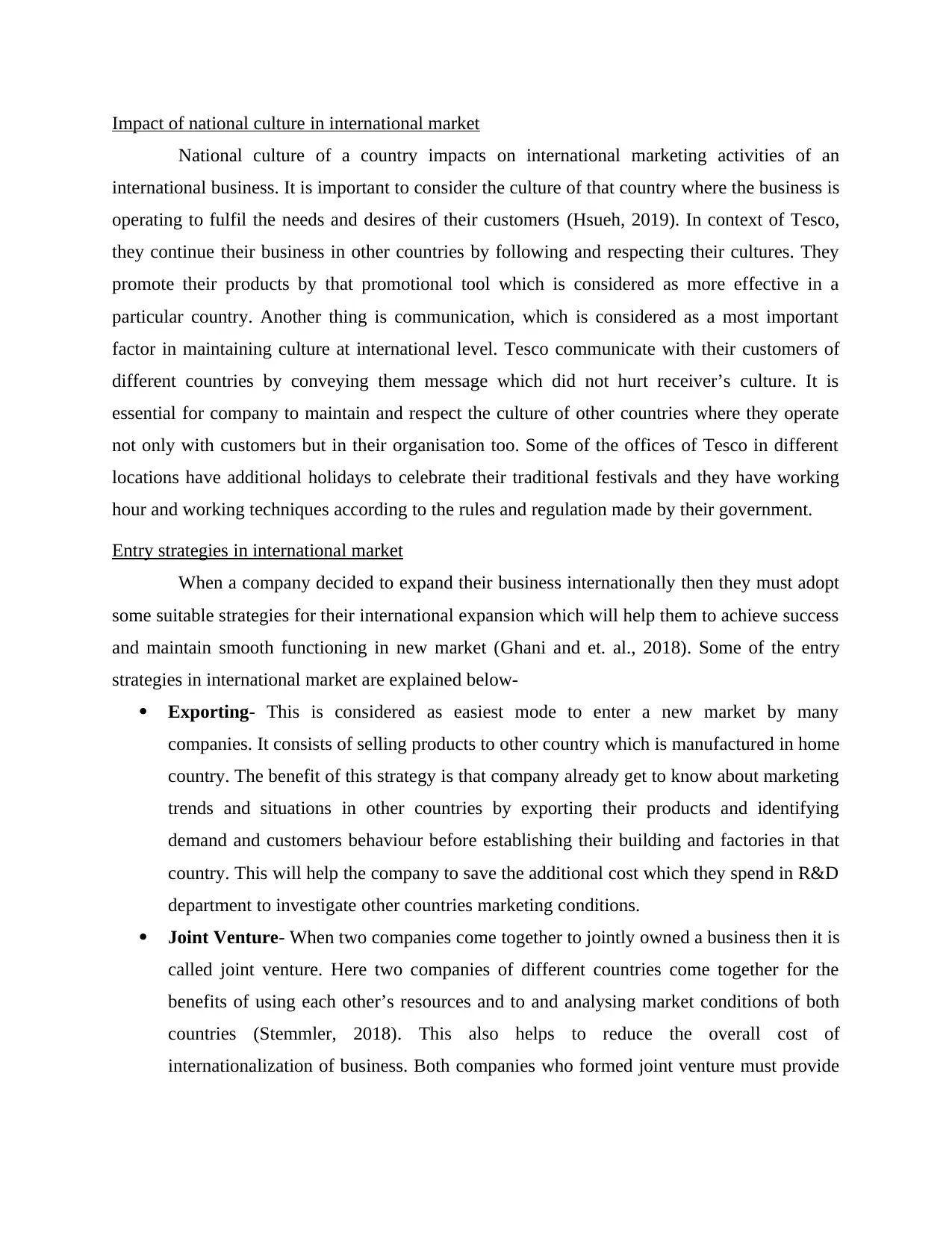
Impact of national culture in international market
National culture of a country impacts on international marketing activities of an
international business. It is important to consider the culture of that country where the business is
operating to fulfil the needs and desires of their customers (Hsueh, 2019). In context of Tesco,
they continue their business in other countries by following and respecting their cultures. They
promote their products by that promotional tool which is considered as more effective in a
particular country. Another thing is communication, which is considered as a most important
factor in maintaining culture at international level. Tesco communicate with their customers of
different countries by conveying them message which did not hurt receiver’s culture. It is
essential for company to maintain and respect the culture of other countries where they operate
not only with customers but in their organisation too. Some of the offices of Tesco in different
locations have additional holidays to celebrate their traditional festivals and they have working
hour and working techniques according to the rules and regulation made by their government.
Entry strategies in international market
When a company decided to expand their business internationally then they must adopt
some suitable strategies for their international expansion which will help them to achieve success
and maintain smooth functioning in new market (Ghani and et. al., 2018). Some of the entry
strategies in international market are explained below-
Exporting- This is considered as easiest mode to enter a new market by many
companies. It consists of selling products to other country which is manufactured in home
country. The benefit of this strategy is that company already get to know about marketing
trends and situations in other countries by exporting their products and identifying
demand and customers behaviour before establishing their building and factories in that
country. This will help the company to save the additional cost which they spend in R&D
department to investigate other countries marketing conditions.
Joint Venture- When two companies come together to jointly owned a business then it is
called joint venture. Here two companies of different countries come together for the
benefits of using each other’s resources and to and analysing market conditions of both
countries (Stemmler, 2018). This also helps to reduce the overall cost of
internationalization of business. Both companies who formed joint venture must provide
National culture of a country impacts on international marketing activities of an
international business. It is important to consider the culture of that country where the business is
operating to fulfil the needs and desires of their customers (Hsueh, 2019). In context of Tesco,
they continue their business in other countries by following and respecting their cultures. They
promote their products by that promotional tool which is considered as more effective in a
particular country. Another thing is communication, which is considered as a most important
factor in maintaining culture at international level. Tesco communicate with their customers of
different countries by conveying them message which did not hurt receiver’s culture. It is
essential for company to maintain and respect the culture of other countries where they operate
not only with customers but in their organisation too. Some of the offices of Tesco in different
locations have additional holidays to celebrate their traditional festivals and they have working
hour and working techniques according to the rules and regulation made by their government.
Entry strategies in international market
When a company decided to expand their business internationally then they must adopt
some suitable strategies for their international expansion which will help them to achieve success
and maintain smooth functioning in new market (Ghani and et. al., 2018). Some of the entry
strategies in international market are explained below-
Exporting- This is considered as easiest mode to enter a new market by many
companies. It consists of selling products to other country which is manufactured in home
country. The benefit of this strategy is that company already get to know about marketing
trends and situations in other countries by exporting their products and identifying
demand and customers behaviour before establishing their building and factories in that
country. This will help the company to save the additional cost which they spend in R&D
department to investigate other countries marketing conditions.
Joint Venture- When two companies come together to jointly owned a business then it is
called joint venture. Here two companies of different countries come together for the
benefits of using each other’s resources and to and analysing market conditions of both
countries (Stemmler, 2018). This also helps to reduce the overall cost of
internationalization of business. Both companies who formed joint venture must provide
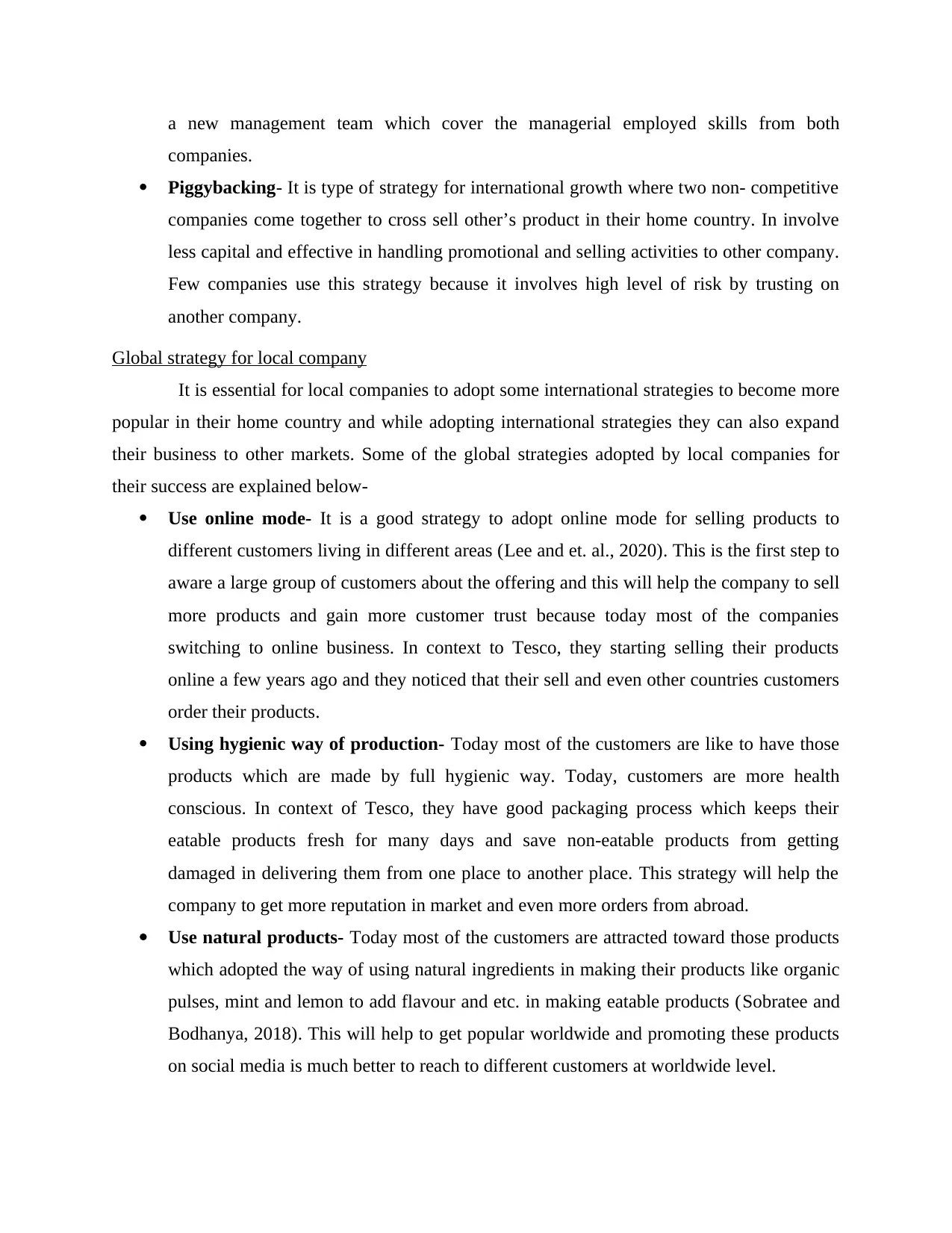
a new management team which cover the managerial employed skills from both
companies.
Piggybacking- It is type of strategy for international growth where two non- competitive
companies come together to cross sell other’s product in their home country. In involve
less capital and effective in handling promotional and selling activities to other company.
Few companies use this strategy because it involves high level of risk by trusting on
another company.
Global strategy for local company
It is essential for local companies to adopt some international strategies to become more
popular in their home country and while adopting international strategies they can also expand
their business to other markets. Some of the global strategies adopted by local companies for
their success are explained below-
Use online mode- It is a good strategy to adopt online mode for selling products to
different customers living in different areas (Lee and et. al., 2020). This is the first step to
aware a large group of customers about the offering and this will help the company to sell
more products and gain more customer trust because today most of the companies
switching to online business. In context to Tesco, they starting selling their products
online a few years ago and they noticed that their sell and even other countries customers
order their products.
Using hygienic way of production- Today most of the customers are like to have those
products which are made by full hygienic way. Today, customers are more health
conscious. In context of Tesco, they have good packaging process which keeps their
eatable products fresh for many days and save non-eatable products from getting
damaged in delivering them from one place to another place. This strategy will help the
company to get more reputation in market and even more orders from abroad.
Use natural products- Today most of the customers are attracted toward those products
which adopted the way of using natural ingredients in making their products like organic
pulses, mint and lemon to add flavour and etc. in making eatable products (Sobratee and
Bodhanya, 2018). This will help to get popular worldwide and promoting these products
on social media is much better to reach to different customers at worldwide level.
companies.
Piggybacking- It is type of strategy for international growth where two non- competitive
companies come together to cross sell other’s product in their home country. In involve
less capital and effective in handling promotional and selling activities to other company.
Few companies use this strategy because it involves high level of risk by trusting on
another company.
Global strategy for local company
It is essential for local companies to adopt some international strategies to become more
popular in their home country and while adopting international strategies they can also expand
their business to other markets. Some of the global strategies adopted by local companies for
their success are explained below-
Use online mode- It is a good strategy to adopt online mode for selling products to
different customers living in different areas (Lee and et. al., 2020). This is the first step to
aware a large group of customers about the offering and this will help the company to sell
more products and gain more customer trust because today most of the companies
switching to online business. In context to Tesco, they starting selling their products
online a few years ago and they noticed that their sell and even other countries customers
order their products.
Using hygienic way of production- Today most of the customers are like to have those
products which are made by full hygienic way. Today, customers are more health
conscious. In context of Tesco, they have good packaging process which keeps their
eatable products fresh for many days and save non-eatable products from getting
damaged in delivering them from one place to another place. This strategy will help the
company to get more reputation in market and even more orders from abroad.
Use natural products- Today most of the customers are attracted toward those products
which adopted the way of using natural ingredients in making their products like organic
pulses, mint and lemon to add flavour and etc. in making eatable products (Sobratee and
Bodhanya, 2018). This will help to get popular worldwide and promoting these products
on social media is much better to reach to different customers at worldwide level.
⊘ This is a preview!⊘
Do you want full access?
Subscribe today to unlock all pages.

Trusted by 1+ million students worldwide
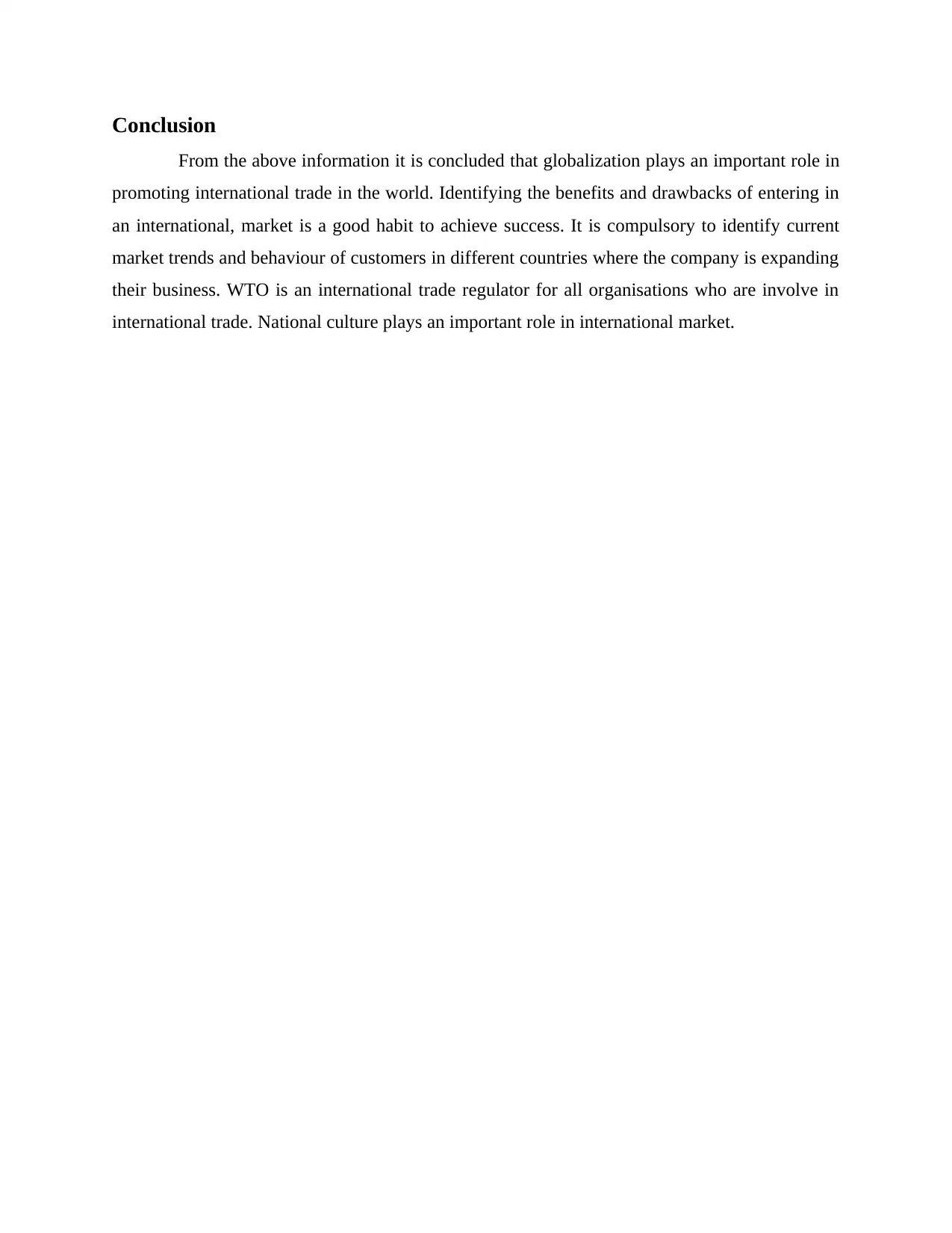
Conclusion
From the above information it is concluded that globalization plays an important role in
promoting international trade in the world. Identifying the benefits and drawbacks of entering in
an international, market is a good habit to achieve success. It is compulsory to identify current
market trends and behaviour of customers in different countries where the company is expanding
their business. WTO is an international trade regulator for all organisations who are involve in
international trade. National culture plays an important role in international market.
From the above information it is concluded that globalization plays an important role in
promoting international trade in the world. Identifying the benefits and drawbacks of entering in
an international, market is a good habit to achieve success. It is compulsory to identify current
market trends and behaviour of customers in different countries where the company is expanding
their business. WTO is an international trade regulator for all organisations who are involve in
international trade. National culture plays an important role in international market.
Paraphrase This Document
Need a fresh take? Get an instant paraphrase of this document with our AI Paraphraser
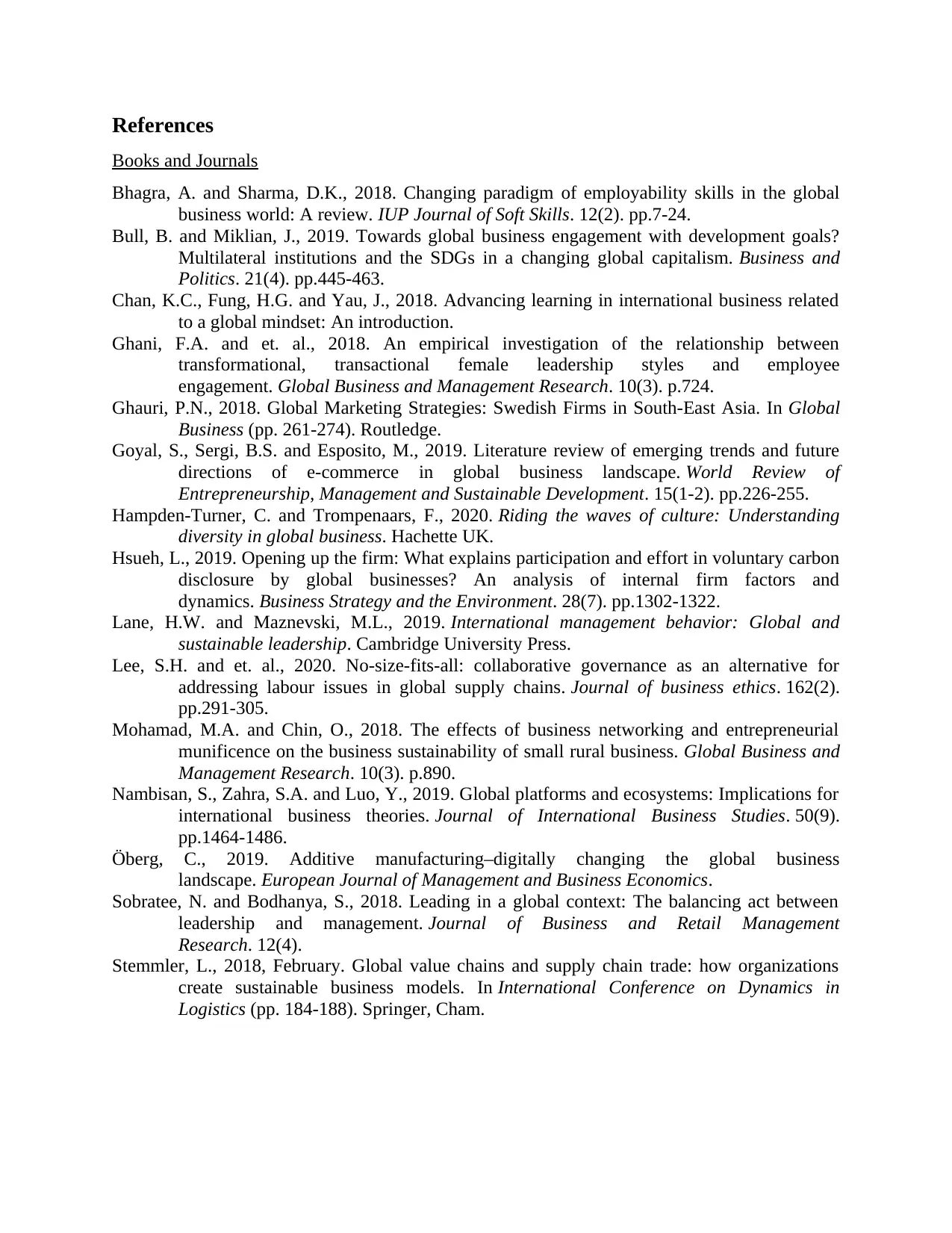
References
Books and Journals
Bhagra, A. and Sharma, D.K., 2018. Changing paradigm of employability skills in the global
business world: A review. IUP Journal of Soft Skills. 12(2). pp.7-24.
Bull, B. and Miklian, J., 2019. Towards global business engagement with development goals?
Multilateral institutions and the SDGs in a changing global capitalism. Business and
Politics. 21(4). pp.445-463.
Chan, K.C., Fung, H.G. and Yau, J., 2018. Advancing learning in international business related
to a global mindset: An introduction.
Ghani, F.A. and et. al., 2018. An empirical investigation of the relationship between
transformational, transactional female leadership styles and employee
engagement. Global Business and Management Research. 10(3). p.724.
Ghauri, P.N., 2018. Global Marketing Strategies: Swedish Firms in South-East Asia. In Global
Business (pp. 261-274). Routledge.
Goyal, S., Sergi, B.S. and Esposito, M., 2019. Literature review of emerging trends and future
directions of e-commerce in global business landscape. World Review of
Entrepreneurship, Management and Sustainable Development. 15(1-2). pp.226-255.
Hampden-Turner, C. and Trompenaars, F., 2020. Riding the waves of culture: Understanding
diversity in global business. Hachette UK.
Hsueh, L., 2019. Opening up the firm: What explains participation and effort in voluntary carbon
disclosure by global businesses? An analysis of internal firm factors and
dynamics. Business Strategy and the Environment. 28(7). pp.1302-1322.
Lane, H.W. and Maznevski, M.L., 2019. International management behavior: Global and
sustainable leadership. Cambridge University Press.
Lee, S.H. and et. al., 2020. No-size-fits-all: collaborative governance as an alternative for
addressing labour issues in global supply chains. Journal of business ethics. 162(2).
pp.291-305.
Mohamad, M.A. and Chin, O., 2018. The effects of business networking and entrepreneurial
munificence on the business sustainability of small rural business. Global Business and
Management Research. 10(3). p.890.
Nambisan, S., Zahra, S.A. and Luo, Y., 2019. Global platforms and ecosystems: Implications for
international business theories. Journal of International Business Studies. 50(9).
pp.1464-1486.
Öberg, C., 2019. Additive manufacturing–digitally changing the global business
landscape. European Journal of Management and Business Economics.
Sobratee, N. and Bodhanya, S., 2018. Leading in a global context: The balancing act between
leadership and management. Journal of Business and Retail Management
Research. 12(4).
Stemmler, L., 2018, February. Global value chains and supply chain trade: how organizations
create sustainable business models. In International Conference on Dynamics in
Logistics (pp. 184-188). Springer, Cham.
Books and Journals
Bhagra, A. and Sharma, D.K., 2018. Changing paradigm of employability skills in the global
business world: A review. IUP Journal of Soft Skills. 12(2). pp.7-24.
Bull, B. and Miklian, J., 2019. Towards global business engagement with development goals?
Multilateral institutions and the SDGs in a changing global capitalism. Business and
Politics. 21(4). pp.445-463.
Chan, K.C., Fung, H.G. and Yau, J., 2018. Advancing learning in international business related
to a global mindset: An introduction.
Ghani, F.A. and et. al., 2018. An empirical investigation of the relationship between
transformational, transactional female leadership styles and employee
engagement. Global Business and Management Research. 10(3). p.724.
Ghauri, P.N., 2018. Global Marketing Strategies: Swedish Firms in South-East Asia. In Global
Business (pp. 261-274). Routledge.
Goyal, S., Sergi, B.S. and Esposito, M., 2019. Literature review of emerging trends and future
directions of e-commerce in global business landscape. World Review of
Entrepreneurship, Management and Sustainable Development. 15(1-2). pp.226-255.
Hampden-Turner, C. and Trompenaars, F., 2020. Riding the waves of culture: Understanding
diversity in global business. Hachette UK.
Hsueh, L., 2019. Opening up the firm: What explains participation and effort in voluntary carbon
disclosure by global businesses? An analysis of internal firm factors and
dynamics. Business Strategy and the Environment. 28(7). pp.1302-1322.
Lane, H.W. and Maznevski, M.L., 2019. International management behavior: Global and
sustainable leadership. Cambridge University Press.
Lee, S.H. and et. al., 2020. No-size-fits-all: collaborative governance as an alternative for
addressing labour issues in global supply chains. Journal of business ethics. 162(2).
pp.291-305.
Mohamad, M.A. and Chin, O., 2018. The effects of business networking and entrepreneurial
munificence on the business sustainability of small rural business. Global Business and
Management Research. 10(3). p.890.
Nambisan, S., Zahra, S.A. and Luo, Y., 2019. Global platforms and ecosystems: Implications for
international business theories. Journal of International Business Studies. 50(9).
pp.1464-1486.
Öberg, C., 2019. Additive manufacturing–digitally changing the global business
landscape. European Journal of Management and Business Economics.
Sobratee, N. and Bodhanya, S., 2018. Leading in a global context: The balancing act between
leadership and management. Journal of Business and Retail Management
Research. 12(4).
Stemmler, L., 2018, February. Global value chains and supply chain trade: how organizations
create sustainable business models. In International Conference on Dynamics in
Logistics (pp. 184-188). Springer, Cham.
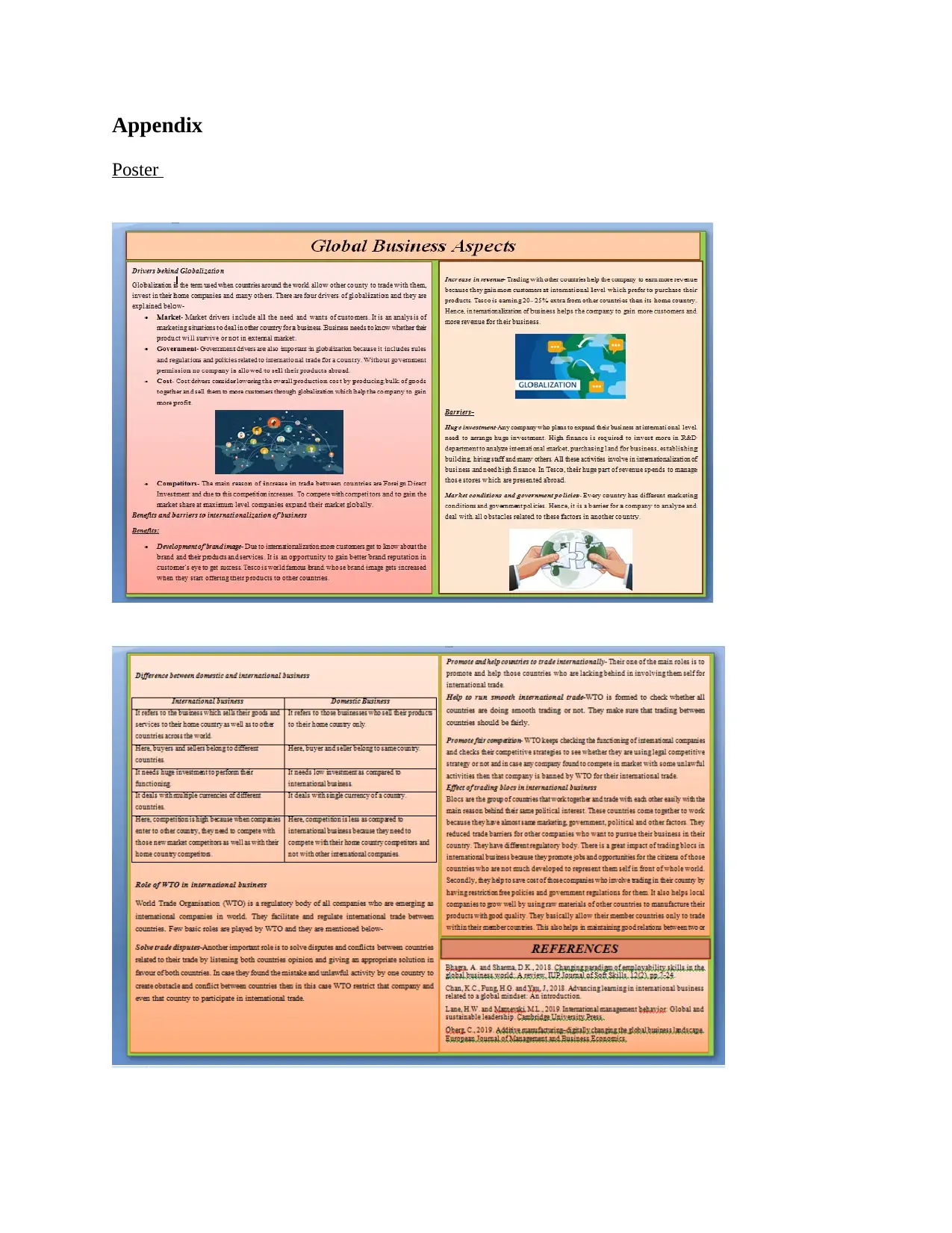
Appendix
Poster
Poster
⊘ This is a preview!⊘
Do you want full access?
Subscribe today to unlock all pages.

Trusted by 1+ million students worldwide
1 out of 9
Related Documents
Your All-in-One AI-Powered Toolkit for Academic Success.
+13062052269
info@desklib.com
Available 24*7 on WhatsApp / Email
![[object Object]](/_next/static/media/star-bottom.7253800d.svg)
Unlock your academic potential
Copyright © 2020–2025 A2Z Services. All Rights Reserved. Developed and managed by ZUCOL.


